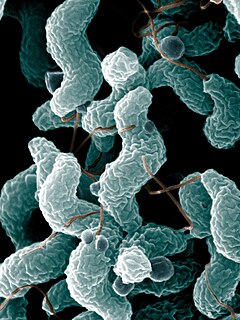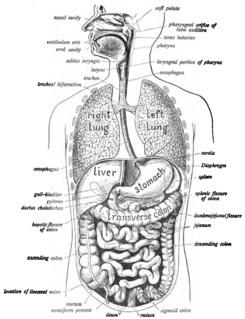
The gastrointestinal tract is an organ system within humans and other animals which takes in food, digests it to extract and absorb energy and nutrients, and expels the remaining waste as feces. The mouth, esophagus, stomach and intestines are part of the gastrointestinal tract. Gastrointestinal is an adjective meaning of or pertaining to the stomach and intestines. A tract is a collection of related anatomic structures or a series of connected body organs.

Trichomonas is a genus of anaerobic excavate parasites of vertebrates. It was first discovered by Alfred François Donné in 1836 when he found these parasites in the pus of a patient suffering from vaginitis, an inflammation of the vagina. Donné named the genus from its morphological characteristics. The prefix tricho- originates from the Ancient Greek word θρίξ (thrix) meaning hair, describing Trichomonas’s flagella. The suffix -monas, describes its similarity to unicellular organisms from the genus Monas.

The Actinomycetales are an order of Actinobacteria. A member of the order is often called an actinomycete.

Epsilonproteobacteria are a class of Proteobacteria. All species of this class are, like all Proteobacteria, Gram-negative.
Neocallimastigomycota is a phylum containing anaerobic fungi, which are symbionts found in the digestive tracts of larger herbivores. Anaerobic fungi were originally placed within phylum Chytridiomycota, within Order Neocallimastigales but later raised to phylum level, a decision upheld by later phylogenetic reconstructions. It encompasses only one family.
Gastrointestinal physiology is the branch of human physiology that addresses the physical function of the gastrointestinal (GI) tract. The function of the GI tract is to process ingested food by mechanical and chemical means, extract nutrients and excrete waste products. The GI tract is composed of the alimentary canal, that runs from the mouth to the anus, as well as the associated glands, chemicals, hormones, and enzymes that assist in digestion.The major processes that occur in the GI tract are: motility, secretion, regulation, digestion and circulation. The proper function and coordination of these processes are vital for maintaining good health by providing for the effective digestion and uptake of nutrients.
Serratia proteamaculans is a Gram-negative, facultatively anaerobic, rod-shaped bacterium. S. proteamaculans HY-3 isolated from the digestive tract of a spider produces an extracellular protease named arazyme, with an estimated molecular mass of 51.5 kDa.

Actinobacillus is a genus of Gram-negative, nonmotile and non-spore-forming, oval to rod-shaped bacteria occurring as parasites or pathogens in mammals, birds, and reptiles. It is a member of the family Pasteurellaceae. The bacteria are facultatively anaerobic or aerobic, capable of fermenting carbohydrates, and of reducing nitrates. The genomic DNA contains between 40 and 47 mol % guanine plus cytosine.
Spironucleus is a diplomonad genus that is bilaterally symmetrical and can be found in various animal hosts. This genus is a binucleate flagellate, which is able to live in the anaerobic conditions of animal intestinal tracts. A characteristic of Spironucleus that is common to all metamonads is that it does not have aerobic mitochondria, but instead rely on hydrogenosomes to produce energy. Spironucleus has six anterior and two posterior flagella. The life cycle of Spironucleus involves one active trophozoite stage and one inactive cyst stage. Spironucleus undergoes asexual reproduction via longitudinal binary fission. Spironucleusvortens can cause lateral line erosion in freshwater anglefish. Spironucleuscolumbae is found to cause hexamitiasis in pigeons. Finally, Spironucleusmuris is found to cause illnesses of the digestive system in mice, rats, and hamsters. The genome of Spironucleus has been studied to exhibit the role of lateral gene transfer from prokaryotes in allowing for anaerobic metabolic processes in diplomonads.
Porphyromonas is a Gram-negative, non-spore-forming, obligately anaerobic and non-motile genus from the family of Porphyromonadaceae. This genus has been found to be part of the salivary microbiome. The use of targeted 16S rRNA gene metagenomic sequencing has shown that the genus is well represented in healthy individuals from the Human Microbiome Project.
Piromyces is a genus of fungi in the family Neocallimastigaceae.
Ixorheorida is an order within the subclass Conoidasida of the phylum Apicomplexia. All members of this order are parasitic protozoa.
Aggregata is a genus of parasitic alveolates belonging to the phylum Apicomplexa.
Ixorheis is a genus of parasitic alveolates in the phylum Apicomplexa.

The human digestive system consists of the gastrointestinal tract plus the accessory organs of digestion. Digestion involves the breakdown of food into smaller and smaller components, until they can be absorbed and assimilated into the body. The process of digestion has three stages. The first stage is the cephalic phase of digestion which begins with gastric secretions in response to the sight and smell of food. This stage includes the mechanical breakdown of food by chewing, and the chemical breakdown by digestive enzymes, that takes place in the mouth.
Victivallis vadensis is a Gram-negative, coccus-shaped, bacteria found in the human digestive tract. It measures approximately 0.5-1.3 micrometers in diameter, is non-motile and chemoorganotrophic, and does not form spores. Victivallis vadensis is strictly anaerobic, as are 90 percent of the bacteria in the human gastrointestinal system.
Oscillibacter valericigenes is a species of mesophilic bacterium identified in the alimentary canal of Japanese Corbicula clams. It is Gram-negative and anaerobic, with a straight to slightly curved rod-like morphology, and is motile with petritrichous flagella. It was not observed in culture to form spores.
The Ganymedidae are a family of parasites in the phylum Apicomplexa.
Methanogens are a group of microorganisms that can produce methane as a byproduct of their metabolism.They hold an important place in the digestive system of ruminants. The digestive tract of ruminants contain four major parts, they are abomasum, rumen, omasum and reticulum.The food with saliva is first passed to the rumen for breaking them into smaller particles and then it moves to the reticulum where the food is broken into further smaller particles and the indigestable particles are sent back for rechewing and then to rumen. The majority of the anaerobic microbes assisting the cellulose breakdown occupy the rumen. They initiate the fermentation process.The animal absorbs the fatty acids, vitamins and nutrient content on passing the partially digested food from rumen to omasum which, decreases the pH level and thus initiates the release of enzymes for further break down the food which is later passed to the abomasumthat absorbs remaining nutrients before excretion.This process takes about 9–12 hours.
Mucinivorans is an anaerobic bacterial genus from the family of Rikenellaceae with one known species. Mucinivorans hirudinis has been isolated from the digestrive tract of the leech Hirudo verbana.




